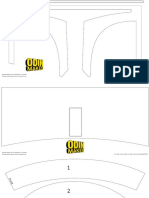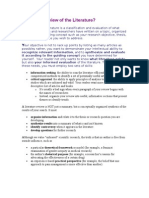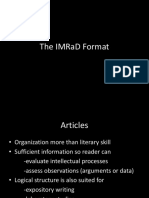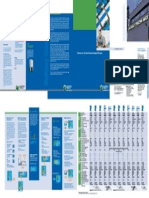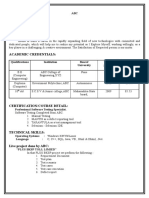100%(1)100% found this document useful (1 vote)
140 viewsResearch Paper Writing
Research Paper Writing
Uploaded by
sowsthikThis document provides an overview of the research process from conducting research to publishing papers. It discusses the meaning and types of research, how to structure a research manuscript, and the publication and peer review process. The types of research covered are descriptive, analytical, applied, fundamental, quantitative, qualitative, conceptual, empirical, longitudinal, field/laboratory/simulation, clinical, exploratory, and historical. Key sections of a research manuscript like the introduction, methods, results, and discussion are also described. The document concludes with tips for deciding to publish, choosing a journal, and understanding the peer review process.
Copyright:
© All Rights Reserved
Available Formats
Download as PPT, PDF, TXT or read online from Scribd
Research Paper Writing
Research Paper Writing
Uploaded by
sowsthik100%(1)100% found this document useful (1 vote)
140 views30 pagesThis document provides an overview of the research process from conducting research to publishing papers. It discusses the meaning and types of research, how to structure a research manuscript, and the publication and peer review process. The types of research covered are descriptive, analytical, applied, fundamental, quantitative, qualitative, conceptual, empirical, longitudinal, field/laboratory/simulation, clinical, exploratory, and historical. Key sections of a research manuscript like the introduction, methods, results, and discussion are also described. The document concludes with tips for deciding to publish, choosing a journal, and understanding the peer review process.
Original Description:
How to write a research paper
Copyright
© © All Rights Reserved
Available Formats
PPT, PDF, TXT or read online from Scribd
Share this document
Did you find this document useful?
Is this content inappropriate?
This document provides an overview of the research process from conducting research to publishing papers. It discusses the meaning and types of research, how to structure a research manuscript, and the publication and peer review process. The types of research covered are descriptive, analytical, applied, fundamental, quantitative, qualitative, conceptual, empirical, longitudinal, field/laboratory/simulation, clinical, exploratory, and historical. Key sections of a research manuscript like the introduction, methods, results, and discussion are also described. The document concludes with tips for deciding to publish, choosing a journal, and understanding the peer review process.
Copyright:
© All Rights Reserved
Available Formats
Download as PPT, PDF, TXT or read online from Scribd
Download as ppt, pdf, or txt
100%(1)100% found this document useful (1 vote)
140 views30 pagesResearch Paper Writing
Research Paper Writing
Uploaded by
sowsthikThis document provides an overview of the research process from conducting research to publishing papers. It discusses the meaning and types of research, how to structure a research manuscript, and the publication and peer review process. The types of research covered are descriptive, analytical, applied, fundamental, quantitative, qualitative, conceptual, empirical, longitudinal, field/laboratory/simulation, clinical, exploratory, and historical. Key sections of a research manuscript like the introduction, methods, results, and discussion are also described. The document concludes with tips for deciding to publish, choosing a journal, and understanding the peer review process.
Copyright:
© All Rights Reserved
Available Formats
Download as PPT, PDF, TXT or read online from Scribd
Download as ppt, pdf, or txt
You are on page 1of 30
Table of Contents
Part I: Introduction to research
Meaning of research
Significance of research
Criteria of good research
Types of research
Part II : Writing a scientific /Research manuscript
Why to write and publish paper?
Why few not write research paper ? Give it a try
Manuscript structure
Part III : Publication and peer review
Types of research
Descriptive research- It includes surveys and fact finding enquiries of
different kinds
Analytical research-The researcher has to use facts or information
already available and analyze them to make a critical evaluation of the
material.
Applied research- It aims at finding a solution for an immediate
problem faced by society or by an industrial /business organization.
Fundamental research-It is mainly concerned with generalizations
and with the formulation of theory. Research concerning with natural
phenomenon or relating to human behaviour , pure mathematics are
example of fundamental research.
Quantitative research It is based on the measurement of quantity or
amount . eg How to increase the productivity?
How to raise the capacity of the plant?
Qualitative research It is concerned with qualitative phenomenon .
For instance we are interested in investigating the reasons for human
behaviour .
Conceptual research It is related to some abstract ideas or theory. It is
generally used by philosophers and thinkers to develop new concepts or
to reinterpret existing ones.
Empirical research It is data based research , coming up with
conclusions which are capable of being verified by observation or by
experiment.
One time or longitudinal research- This type of research is
confined to a single time-period.
Field setting or laboratory or simulation research This type of
research depends upon the environment in which it is carried out.
Clinical or diagnostic research This type of research follows
case study methods or indepth approaches to reach the basic
causal relations.
Exploratory research- In this type hypothesis are developed and
tested
Historical research- It deals with past historical documents and
past historical data
Why to write and publish research papers?
Ideally
to get a research degree along with its consequential benefits
desire to face the challenge in solving the unsolved problems
to share research findings and discoveries .
Practically
to get funding
to get promoted
to get a job
to contribute to your institution ( eg program accreditation)
contribute to your field
to keep your job!
Personal satisfaction and development
Why few not write research papers ?
Give it a try
Some of the common
barriers are
Lack of time
Unfamiliarity with
the process (dont
know where to
begin)
Bad experiences
(rejection &
criticism)
Planning strategies
can help
Its not really that
complicated
Everyone gets
rejected but
persistence pays
Manuscript Structure
Title
Abstract
Keywords
Introduction
Body of Article
Results
Discussion and Conclusions
Acknowledgements
References
Figures and Tables
8
Choose a Right Title
The title should be very specific, not too broad.
The title should be substantially different from others.
Women enterpreneurs in micro, small and medium enterprises (MSME ) ,
IJM .
Intelligent system for assisting decisions in advance product and process
planning and design JMPT
Distributed topology control for power efficient operation in multihop wireless
networks, infocom01.
Avoid general / big titles, e.g.,
Research on data mining,
Some research on job assignment in cluster computing,
A new framework for distributed computing,
9
2.3.2 Write a concise Abstract
The abstract is the summary/ mirror of the full manuscript .
An abstract is the highly condensed version of a complete paper
Commonly 250 to 300 words
An abstract should tell:
Problem investigated - the problem that the paper discusses.
Purpose of research
Methods - the work that has been done, or method being used.
Results - original findings / achievements
Conclusions
The use of an abstract:
for search purpose.
giving readers a paper-summary before getting into details.
An abstract usually does NOT have:
reference numbers
multiple paragraphs
Abstract
Common Mistakes
Too much background or methods information
Figures or images
References to other literature, figures or images
Abbreviations or acronyms
11
Choose a right set of keywords
The keywords must be specific and, as a whole,
represent the main topic of the paper.
Avoid using the words that are not the main topic, such
as calculus, simulations, etc.
The use of keywords:
database search,
categorizing your work (for editors to choose reviewers).
Introduction-the most difficult part
Purpose of introduction:
Introducing readers to your problem / work.
Need for this study
Achievement / significance / brief-methodology of work
Broad information on topic - brief background of the topic area
Existing work, which would lead to the importance / originality of your work
Previous research should include a concise review of the relevant
literature - What is known already?
What knowledge gap exists?
How will this contribute ?
Focus of paper
Hypothesis
Summary of problem
Overall 300-500 words
Introduction
Common Mistakes
Too much or not enough information
Unclear purpose
Lists
Confusing structure
First-Person anecdotes
2.3.6 Methods and Materials
Provides instruction on exactly how to repeat experiment
Subjects
Sample preparation techniques
Sample origins
Field site description
Data collection protocol
Data analysis techniques
Any computer programs used
Description of equipment and its use
Methods and Materials
Common Mistakes
Too little information
Information from Introduction
Verbosity
Results/ sources of error reported
Results
Objective presentation of experiment results
Summary of data
NOT a Discussion!
Common mistakes
Raw data
Redundancy
Discussion and interpretation of data
No figures or tables
Methods/materials reported
2.3.8 Discussion
Interpret results
Did the study confirm/deny the hypothesis?
If not, did the results provide an alternative hypothesis? What
interpretation can be made?
Do results agree with other research? Sources of
error/anomalous data?
Implications of study for field
Suggestions for improvement and future research?
Relate to previous research
Discussion
Common Mistakes
Combined with Results
New results discussed
Broad statements
Incorrectly discussing inconclusive results
Ambiguous data sources
Missing information
Figures and Tables
Tables
Presents lists of numbers/ text in columns
Figures
Visual representation of results or illustration of
concepts/methods (graphs, images, diagrams, etc.)
Captions
Must be stand-alone
Figures and Tables
Guidelines for Figures and Tables
High resolution
Neat, legible labels
Simple
Clearly formatted
Indicate error
Detailed captions
References
Check specific referencing style of journal
Should reference:
Peer-reviewed journal articles, abstracts, books
Should not reference:
Non-peer-reviewed works, textbooks, personal communications
Common Mistakes
Format, Format, Format
(Figures & Tables, Equations, and References)
Redundant Information
Text, Figures, Tables, and Captions
Type of Reference
Part I: Publication & Peer
Review:
Part III : Publication & Peer Review:
Deciding to Publish and Submitting Your Paper
What to publish?
abstract vs. full report
Choosing your forum
Which type of journal is best for you?
What audience are you targeting?
Research the journal
Publication guidelines
Article style
The seven deadly sins
1. Data manipulation, falsification
2. Duplicate manuscripts
3. Redundant publication
4. Plagiarism
5. Author conflicts of interest
6. Animal use concerns
7. Humans use concerns
Process of Research publication
Completion of research
Preparation of manuscript
Submission of manuscript
Assignment and review
Decision
Revision
Resubmission
Re-review
Acceptance
Publication
Rejection
Rejection
The Journal Process
Editor decides whether to send for review
Peer reviewers assigned
Decision
Accept / Reject
Revise & Resubmit
Prospective authors should not be
disheartened if a manuscript is rejected or
needs extensive rewriting; this is the rule
rather than the exception.
First Impressions
First Impressions
What constitutes a good journal?
Impact factor
average number of times published papers
are cited up to two years after publication.
Immediacy Index
average number of times published papers
are cited during year of publication.
Some Key Tips
Read many papers, and learn from good ones & bad ones
Write frequently: quality is everything
Review frequently
Learn to be objective about your work
Believe that editors/reviewers are likely trying to be objective
about your work
Learn to expect and accept rejection
There is no way to get
experience except through
experience.
You might also like
- Mandalorian Helmet PatternDocument5 pagesMandalorian Helmet Patternaaa67% (3)
- AW189 - Air Vehicle Time Limits - Maintenance ChecksDocument10 pagesAW189 - Air Vehicle Time Limits - Maintenance Checksmortada101No ratings yet
- Sampling in Qualitative ResearchDocument65 pagesSampling in Qualitative ResearchRuben QuibralNo ratings yet
- Thesis Format - QualitativeDocument38 pagesThesis Format - QualitativeIsabel Oñate91% (22)
- Literature ReviewDocument46 pagesLiterature ReviewRadwa Mohamed83% (6)
- GT02A User Manual PDFDocument10 pagesGT02A User Manual PDFsbloinazNo ratings yet
- 1 Writing The Title For Your Research PaperDocument39 pages1 Writing The Title For Your Research PaperSarah Jane Vallar100% (5)
- Developing Research GapDocument2 pagesDeveloping Research Gapshamsukarim2009No ratings yet
- Marketing Information Systems and Marketing ResearchDocument23 pagesMarketing Information Systems and Marketing ResearchDelfa CastillaNo ratings yet
- Writing Research ProposalDocument19 pagesWriting Research ProposalCudak Chris100% (1)
- IMRAD Paper Format - Springer Publishing Company, New York, USA 2014 PDFDocument15 pagesIMRAD Paper Format - Springer Publishing Company, New York, USA 2014 PDFAlexa Abidin OldenborgNo ratings yet
- Writing A Research AbstractDocument10 pagesWriting A Research AbstractJunel Alapa100% (1)
- The Purpose of A Cover LetterDocument6 pagesThe Purpose of A Cover Lettermarilyn del mundoNo ratings yet
- Technical Terms Used in ResearchDocument24 pagesTechnical Terms Used in ResearchMaribel Coyme (bel)No ratings yet
- This Is How To Write An Effective Research PaperDocument9 pagesThis Is How To Write An Effective Research PaperCalima BakegNo ratings yet
- Parts of A ResearchDocument26 pagesParts of A ResearchJuliana MolinaNo ratings yet
- Practical Research Chapter 2Document15 pagesPractical Research Chapter 2Dexter RimorinNo ratings yet
- How To Write Case StudyDocument2 pagesHow To Write Case StudyFaheemKhan88No ratings yet
- The Nature of Quantiative ResearchDocument44 pagesThe Nature of Quantiative ResearchCriselNo ratings yet
- What Is The Function and Role of Needs Analysis in Learning DesignDocument3 pagesWhat Is The Function and Role of Needs Analysis in Learning DesignMUH. YASIN KOLUHU100% (1)
- BMORDocument24 pagesBMORShyne Casin100% (1)
- 1 - Introduction To ResearchDocument72 pages1 - Introduction To Researchmeghrie Artinian100% (4)
- Curriculum As A ProcessDocument5 pagesCurriculum As A ProcessRuben Jr Restificar100% (1)
- Research GuidelinesDocument5 pagesResearch GuidelinesAnonymous QbVyZdzpfnNo ratings yet
- Shs DemoDocument15 pagesShs DemoJose Ruel Rosello MendozaNo ratings yet
- Interview PacketDocument9 pagesInterview PacketroruangNo ratings yet
- What Is LitReviewDocument3 pagesWhat Is LitReviewSifu KNo ratings yet
- Identifying The Research Problem: A/Professor Denis Mclaughlin School of Educational LeadershipDocument13 pagesIdentifying The Research Problem: A/Professor Denis Mclaughlin School of Educational LeadershipRizki IftianiNo ratings yet
- Unit 5 Evaluating Information SourcesDocument11 pagesUnit 5 Evaluating Information SourcesMalvern MuzarabaniNo ratings yet
- IMRaD FormatDocument20 pagesIMRaD FormatMichelle Senosin Dimero100% (1)
- Research Problem Significance Scope DelimitationsDocument23 pagesResearch Problem Significance Scope DelimitationsAndreiNo ratings yet
- Writing The Third Chapter "Research Methodology": By: Dr. Seyed Ali FallahchayDocument28 pagesWriting The Third Chapter "Research Methodology": By: Dr. Seyed Ali FallahchayShaneil MatulaNo ratings yet
- ResumeofficialDocument3 pagesResumeofficialapi-247963077No ratings yet
- Thesis StatementDocument15 pagesThesis StatementJos50% (2)
- Business Plan Specs PPT Content and Presentation GuidelinesDocument2 pagesBusiness Plan Specs PPT Content and Presentation GuidelinesMarvinbautistaNo ratings yet
- What Is A Literature Review?Document4 pagesWhat Is A Literature Review?Renju Peter ChackoNo ratings yet
- Curriculum Aims and Outcomes: Chapter OverviewDocument20 pagesCurriculum Aims and Outcomes: Chapter OverviewHoang Anh100% (1)
- CLT EssayDocument4 pagesCLT Essayjamilnurdin954100% (2)
- APA Citation Methods: Brought To You by The Center For Teaching and LearningDocument25 pagesAPA Citation Methods: Brought To You by The Center For Teaching and LearningDayan EsparteroNo ratings yet
- My Research Question: Benefits of Foreign Language Education in Primary SchoolDocument1 pageMy Research Question: Benefits of Foreign Language Education in Primary Schooljwinchell12No ratings yet
- Elements of A Research ProposalDocument131 pagesElements of A Research ProposalAinazik MomunalievaNo ratings yet
- Scientific Research PaperDocument1 pageScientific Research PapermarisakendallNo ratings yet
- Writing A Literature ReviewDocument29 pagesWriting A Literature ReviewGiridhari B ChandrabansiNo ratings yet
- Template On Shs Research SeminarDocument5 pagesTemplate On Shs Research SeminarArn HortizNo ratings yet
- Revising and Editing 1Document11 pagesRevising and Editing 1Adesti KomalasariNo ratings yet
- Non-Literary TextsDocument14 pagesNon-Literary TextsScribdTranslationsNo ratings yet
- The IPO ModelDocument14 pagesThe IPO ModelJosue Berduo SanjuanNo ratings yet
- Research ProposalDocument5 pagesResearch ProposalJahan Nishu100% (1)
- Questionnaire DesignDocument21 pagesQuestionnaire DesignnishithathiNo ratings yet
- Chapter I: The ProblemDocument39 pagesChapter I: The ProblemKryzella ManaoisNo ratings yet
- Gee 4-Topic 3-Lesson1Document8 pagesGee 4-Topic 3-Lesson1Pitel O'shoppeNo ratings yet
- R&W - PPT No. 0 - Basic Reading Skills and Types of ReadingDocument25 pagesR&W - PPT No. 0 - Basic Reading Skills and Types of ReadingBernard M. PaderesNo ratings yet
- 4 2 The IMRaD FormatDocument32 pages4 2 The IMRaD FormatAshley BautistaNo ratings yet
- Writing Scientific PapersDocument50 pagesWriting Scientific Papersivan.cheukNo ratings yet
- Writing Research Paper: A Step by Step Guide: Dr. Racidon P. BernarteDocument66 pagesWriting Research Paper: A Step by Step Guide: Dr. Racidon P. BernarteA.B. CbmNo ratings yet
- Scientific CommunicationDocument47 pagesScientific Communicationhusiensalih100No ratings yet
- Lecture03 NewDocument28 pagesLecture03 Newhabtamu mesfinNo ratings yet
- RM2 PDFDocument48 pagesRM2 PDFbkattriNo ratings yet
- Scholarly Writing: Thesis, Dissertation, Journal ArticlesDocument42 pagesScholarly Writing: Thesis, Dissertation, Journal ArticlesDaniel TanNo ratings yet
- How To Write Research PaperDocument35 pagesHow To Write Research PaperAnagha PranjapeNo ratings yet
- AP 405 - SEMINAR - SN Lecture - How To Conduct A Case StudyDocument22 pagesAP 405 - SEMINAR - SN Lecture - How To Conduct A Case StudyKishan SirohiNo ratings yet
- SDSHF Gjgte Yjh g834Document39 pagesSDSHF Gjgte Yjh g834elgwekwerereNo ratings yet
- Mea PPT 4Document16 pagesMea PPT 4Wilberforce EsongaNo ratings yet
- Tyrannosaurus Rex (Extinct 65 Million Years Ago)Document7 pagesTyrannosaurus Rex (Extinct 65 Million Years Ago)sowsthikNo ratings yet
- Chapter 1 TQM Evolution Ppt2Document31 pagesChapter 1 TQM Evolution Ppt2sowsthikNo ratings yet
- 1 - Principles of MaintenanceDocument15 pages1 - Principles of MaintenancesowsthikNo ratings yet
- Unconventional MachiningDocument11 pagesUnconventional MachiningSaravanan MathiNo ratings yet
- PR1014Document4 pagesPR1014sowsthikNo ratings yet
- CENTERLINE Builder Installation and Registration Instructions V1.0Document4 pagesCENTERLINE Builder Installation and Registration Instructions V1.0Elmer MendozaNo ratings yet
- Passive Voice Activity 2020Document3 pagesPassive Voice Activity 2020David Felipe Moreno ReyesNo ratings yet
- Air CompressorsDocument13 pagesAir CompressorsCalin SeraphimNo ratings yet
- Admit Card 8th SemDocument1 pageAdmit Card 8th SemMD Noorul QuamarNo ratings yet
- Battery Charger BR ENG 09 2012 72dpiDocument2 pagesBattery Charger BR ENG 09 2012 72dpiAnonymous M0OEZEKoGiNo ratings yet
- SPB Cable Tray Systems 2016Document14 pagesSPB Cable Tray Systems 2016Lord KrsnikNo ratings yet
- FAS3210 System Configuration GuideDocument11 pagesFAS3210 System Configuration Guidecmulholl100% (1)
- Method Statement For Chilled Water PipesDocument5 pagesMethod Statement For Chilled Water PipesYoYoRamez100% (1)
- Structural Report - Type 4 Health PostDocument29 pagesStructural Report - Type 4 Health PostSaurav ShahNo ratings yet
- 21Document1,886 pages21Jay R SVNo ratings yet
- Merciline Joy S. Palaje Bsche 5: 10 Periodic Technical Lecture "Basic Energy and Loss Engineering "Document2 pagesMerciline Joy S. Palaje Bsche 5: 10 Periodic Technical Lecture "Basic Energy and Loss Engineering "Merciline Joy S. PalajeNo ratings yet
- 1696 DroneDocument118 pages1696 DroneEri Dya FadliNo ratings yet
- Convocation Report 2012 2013Document27 pagesConvocation Report 2012 2013adityaNo ratings yet
- Spheerol LMMDocument2 pagesSpheerol LMMSabari SreekumarNo ratings yet
- DSE Link 5000 Software ManualDocument61 pagesDSE Link 5000 Software ManualAnonymous vqsuRyNo ratings yet
- Manual Testing Fresher Resume 4Document3 pagesManual Testing Fresher Resume 4ravi singhNo ratings yet
- A Perspective of Toys DesignDocument22 pagesA Perspective of Toys DesignFrancisco Tipan100% (1)
- Aman, Ngadirin Setiawan, Dan Lia Yuliana Universitas Negeri Yogyakarta, Jalan Colombo No. 1 YogyakartaDocument17 pagesAman, Ngadirin Setiawan, Dan Lia Yuliana Universitas Negeri Yogyakarta, Jalan Colombo No. 1 YogyakartaFuad HasyimNo ratings yet
- MTM44 1 Datasheet Issue6Document6 pagesMTM44 1 Datasheet Issue6Leolix PavlixNo ratings yet
- Tsp-Shortest Path-Route-Finding-With-An-Elaborate-Text-File-Csv-Format-ReaderDocument36 pagesTsp-Shortest Path-Route-Finding-With-An-Elaborate-Text-File-Csv-Format-ReaderAnonymous 6RHwiX7No ratings yet
- Extending TransactionsDocument56 pagesExtending TransactionsRachapudi SumanNo ratings yet
- Week 3: Introduction To Sensors' Science and TechnologyDocument14 pagesWeek 3: Introduction To Sensors' Science and TechnologyLaureano Gomez Zabala100% (1)
- MT6592 Android Scatter EmmcDocument6 pagesMT6592 Android Scatter EmmcVenkatesh SridharanNo ratings yet
- THE Tri-Con SeriesDocument6 pagesTHE Tri-Con Seriespablopasqualini18No ratings yet
- Seminar AbstractDocument1 pageSeminar AbstractCool ArvindNo ratings yet
- Tunnel Lenth 3500 M Tunnel Diameter Inside Area (m2) Wetted Perimeter (M)Document26 pagesTunnel Lenth 3500 M Tunnel Diameter Inside Area (m2) Wetted Perimeter (M)Prayas SubediNo ratings yet
- Sapience AgentDocument26 pagesSapience AgentSimin GeorgeNo ratings yet
